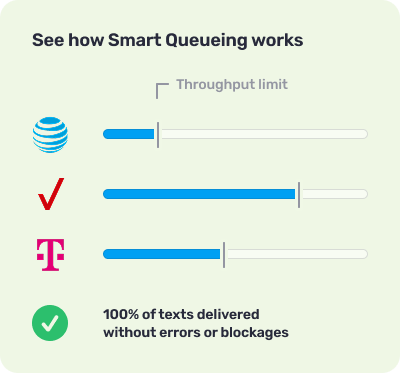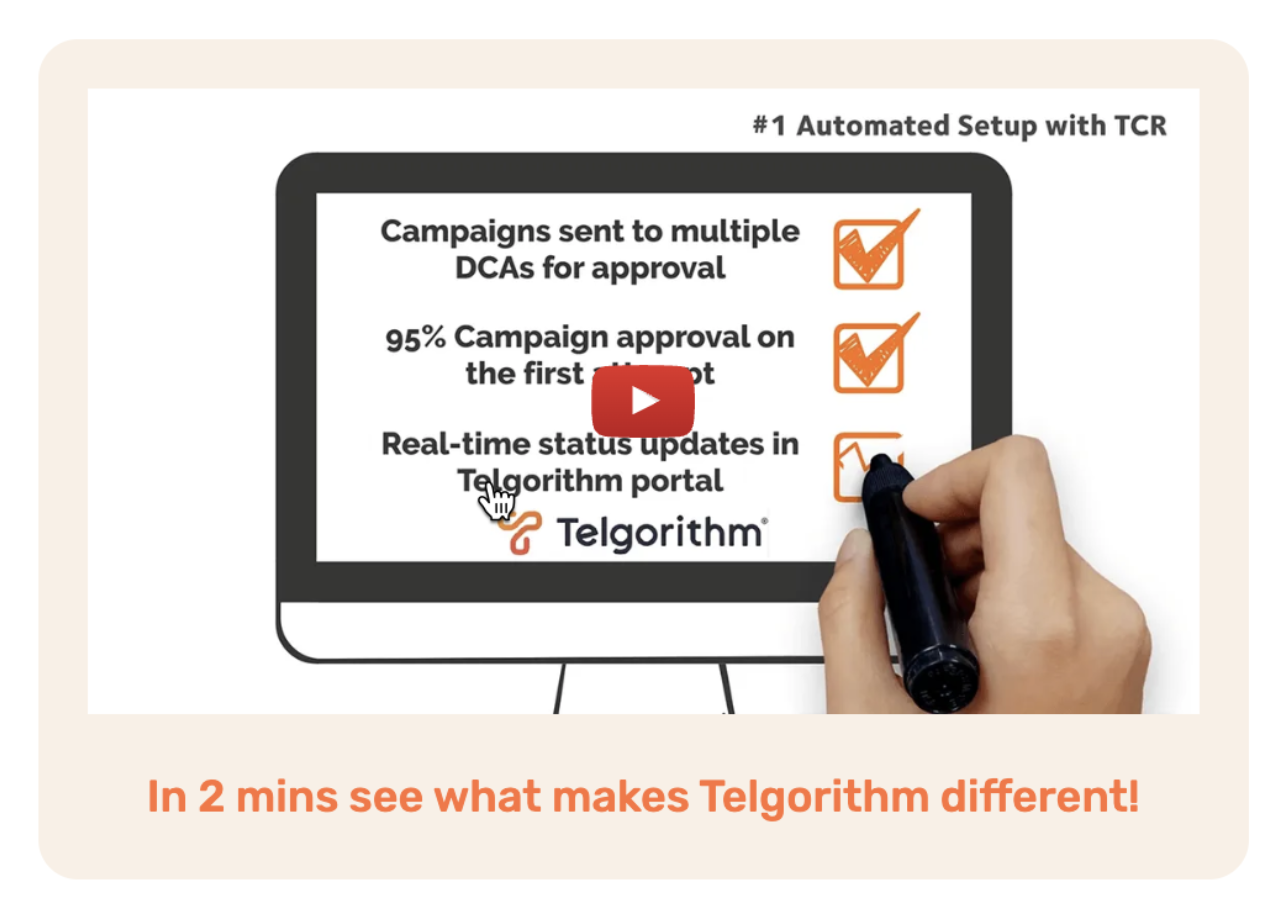To maintain high deliverability and avoid message filtering or carrier penalties, businesses must register their messaging traffic with The Campaign Registry (TCR) and follow A2P 10DLC rules.
.png)
Navigating A2P 10DLC Registration & Vetting with Aaron Alter

Discussing A2P 10DLC (Local Numbers) Registration with...
10DLC vs. Toll-Free: At a Glance
10DLC
Toll-Free
Use Case Examples
Local presence, high-volume alerts
Local presence, high-volume alerts
Throughput
Variable (based on campaign type & vetting score)
Up to 3 MPS by default
Registration Required
Yes (through TCR)
Yes (Verification)
Ideal For
ISVs sending on behalf of SMBs
Direct-to-consumer brands, support lines
Turn-up Cost
$9.50 per day on average
Local presence, high-volume alerts
When does 10DLC make sense?
If your platform or application sends messages on behalf of many end clients or requires a local presence, 10DLC is the right choice. It offers more flexibility in phone number branding, compliance controls, and scalable throughput—especially when supported by Telgorithm’s Smart Queueing.
💬 Example:
If you’re an ISV helping local clinics, insurance agents, or sales reps send appointment reminders or updates via SMS, 10DLC ensures messages come from a local number that recipients recognize—and trust.
When does Toll-Free make sense?
Toll-Free messaging may work better for:
National customer service numbers
Low-volume or 1-way messages
Situations where local presence doesn’t matter
However, it lacks vetting and deliverability controls, and scaling throughput can get expensive fast.
🧠 Telgorithm Tip:
Don’t choose between Toll-Free and 10DLC based on what seems easier to register—choose based on your business needs and message use case.
Toll-Free works well for support lines and national brands. 10DLC is ideal for local presence, higher throughput, and software platforms messaging on behalf of others.
With the right provider, both channels can be compliant and effective.
To send business text messages over 10-digit local numbers in the U.S., you must register your Brand and Campaign(s) with The Campaign Registry (TCR)—the central hub carriers use to vet and verify 10DLC traffic.
There are three core components to 10DLC registration—below is a snapshot of what they entail and who they’re for.
.png)
Navigating A2P 10DLC Registration & Vetting with Aaron Alter
10DLC Registration 101
10DLC Registration 101
Who qualifies as a CSP? Software providers offering messaging to companies or organizations.
Why register? To maintain control, visibility, and ownership over all registered Brands and Campaigns.
Is it required? No, but it’s recommended.
Who approves? TCR reviews and approves CSP registrations.
How much? There is a one-time setup fee of $200.
Brand Registration
What is a Brand? Each business (Brand) sending messages through a platform.
Why register? To verify the identity of the message sender.
Is it required? Yes. You can’t submit Campaigns until your Brand is verified.
Who approves? TCR reviews and verifies Brands.
How much? Standard Brand registration is $4.
Campaign Registration
What is a Campaign? Each message use case the Brand wants to send.
Why register? To define what kind of content will be shared, how recipients opt-in, etc.
Is it required? Yes. Only registered Campaigns are permitted to enter the mobile ecosystem.
Who approves? DCA reviews and approves all Campaigns.
How much? There is a $15 vetting fee per Campaign.
What are the costs associated with TCR Registration?
The below fees are invoiced directly by TCR:
Item
Fee
Occurrence
CSP Sign Up Fee
$200
One time
Low Volume Mixed
$1.50
Monthly for each campaign
Charity
$3
Monthly for each campaign
Emergency
$5
Monthly for each campaign
Sole Proprietor
$2
Monthly for each campaign
CSP Sign Up Fee
$30
Monthly for each campaign
All Other Campaigns (Standard and Special)
$10
Monthly for each campaign
Brand Registration
$4
One time per brand
Standard Vetting
$40
One time per vetting
Political Vetting - Email or standard PIN delivery
$64
One time per vetting
Political Vetting - Express mail PIN delivery
$91.95
One time per vetting
Failed Standard Vet Appeal
$5
Per appeal
Failed Political Vet Appeal
$22
Per appeal
In A2P 10DLC messaging, Campaign Service Providers (CSPs) are the primary users of TCR and are the owners of their registered Brands and Campaigns.
The alternative to being a CSP is being a Reseller, which means you let your Connectivity Partner (CNP), AKA your API provider, register your Brands and Campaigns on your behalf. As a Reseller, you lose ownership of those Brands and Campaigns and lack control over the timing of data entry in TCR, direct visibility into what’s being approved or rejected and why, the ability to directly communicate with TCR, and more.
For these reasons, we strongly encourage all software providers to register as CSPs.
As a Reseller, you:
As a CSP, you:
Distinction?
Provide all Brand details to your API provider (AKA your CNP), including proprietary data like EINs.
Directly input all Brand details in TCR portal yourself. No proprietary data needs to be shared with your provider.
You share the exact same information in both models, but as a Reseller, you’re sharing proprietary data with your provider – as a CSP, you go directly to TCR.
Do not have the freedom
to multi-thread your messaging traffic with more than one API provider as your provider is the “owner” of both your Brands and Campaigns.
Have the freedom and flexibility to multi-thread traffic with more than one provider. You can even select different providers for different Campaigns under one Brand (for the purpose of creating redundancies).
As a CSP you have the ability to multi-thread traffic to create redundancies, test providers, and strengthen your messaging infrastructure.
Cannot easily migrate your registered traffic from one provider to another – as a Reseller, you will have to re-register all Brands and Campaign with TCR if you switch API providers.
Can migrate registered traffic from one API provider to another without having to re-register or repay one-time fees. This is because you are the owner and direct user of your Brands and Campaigns in TCR.
It can be costly and time-consuming to migrate to a new API provider as a Reseller. If you have any existing Brands or Campaigns on a Reseller model with another provider that you want to migrate, reach out for our help in finding an affordable solution!
Cannot get direct help from TCR.
Can reach out to TCR directly for support.
Resellers are dependent on their API providers to solve registration issues, answer questions, or relay updates from TCR.
Registering your 10DLC Campaigns is just the first step. To truly benefit from higher throughput and better deliverability, you need a provider who can intelligently manage the carrier limits you’re approved for. That’s exactly what Telgorithm’s Smart Queueing was built for.
Smart Queueing is our proprietary traffic control layer that:
Monitors your approved 10DLC throughput in real time (MPS per carrier, per Campaign)
Automatically queues messages that exceed those limits—rather than letting them get dropped, filtered, or rejected
Releases messages as capacity becomes available to ensure steady, compliant delivery
The result? On average, a 20% improvement in message deliverability—with no disruption to your workflows.
Why It Matters
Without intelligent queueing, most providers either:
Let messages fail silently (wasting your spend and hurting your brand), or
Force you to build complex rate-limit logic in-house
Telgorithm handles it for you—so your messages stay compliant, on time, and delivered.

🧠 Telgorithm Tip:
Higher throughput means nothing if your provider can’t manage it. Smart Queueing turns registration into real ROI—without extra dev work.
The A2P 10DLC ecosystem is made up of several key players—each with a specific role in ensuring that business text messages are properly registered, approved, and delivered.
Here’s how it all fits together:
The Campaign Registry (TCR): The central hub for 10DLC registration.
Campaign Service Provider (CSP): Entities, such as ISVs, that register and manage Brnads and Campaigns with TCR on behalf of other businesses, AKA their customers.
Connectivity Partner (CNP): The technical enablers that bridge CSPs with DCAs. A CNP manages the messaging infrastructure, enabling compliant traffic flow, routing logic, and deliverability across the ecosystem. Telgorithm is a CSP.
Direct Connect Aggregators (DCAs): Infrastructure partners that connect your registered Campaigns to the mobile carriers. They handle message traffic routing and Campaign approvals.
Mobile Network Operators (MNOs): AT&T, T-Mobile, Verizon, and others—these are the end networks that receive the messages and deliver them to your customers’ phones. They enforce compliance, throughput rules, and carrier pass-through fees.
.svg)
Read these common migration misconceptions.
Switching SMS API providers can feel risky—especially when your business depends on messaging that works. We get it. Your developers worry about integrations. Your compliance team worries about re-registering. Your leadership worries about downtime.
But the reality? Migrating to a better provider like Telgorithm is easier than most teams think. Let’s bust the most common myths:
❌ Myth #1: Recreating Campaigns is a manual nightmare
✅ Truth: With Telgorithm, it’s fully automated.
We use TCR APIs to seamlessly migrate your existing Campaigns and Brand registrations—no need to manually re-enter info or start from scratch.
❌ Myth #2: You’ll lose your vetting score or face major delays
✅ Truth: Your Brand and vetting score follow you.
As long as your business info stays the same, your vetting score travels with you—and our multi-DCA setup often results in faster Campaign approvals than you had before.
❌ Myth #3: The rejections are rough but migration fees would be worse
✅ Truth: You’d pay the same re-vet fee either way.
Whether you’re updating a rejected Campaign or switching providers, the fee is the same. The difference is: with Telgorithm, you’ll actually see results.
Read more misconceptions here >
Telgorithm doesn’t just connect you to the 10DLC ecosystem—we optimize your path through it.
As a registered Campaign Service Provider (CSP), you’ll have full ownership over your Brands and Campaigns inside The Campaign Registry (TCR). That means you control the data and own the relationship—not your upstream provider.
But here’s where we really stand out: Telgorithm is directly integrated with three major Direct Connect Aggregators (DCAs)—giving you unmatched flexibility and redundancy.
While most providers limit you to a single DCA (which can lead to bottlenecks or delays), Telgorithm’s multi-DCA architecture allows us to:
Route Campaigns dynamically for faster approvals (within 24 hours on average)
Avoid disruptions if a DCA experiences downtime or congestion
Offer smarter escalations and error handling
Maximize deliverability across carriers
Your Campaigns don’t get stuck in one lane—we move them forward.
Where Telgorithm Sits in the A2P 10DLC Ecosystem

.avif)
Why this matters for ISVs:
Faster time-to-text for your customers
Fewer compliance headaches & rejections
Greater resilience in an unpredictable ecosystem
When you combine CSP ownership with Telgorithm’s multi-DCA setup, you get the most transparent, efficient, and future-proof 10DLC experience available.

Need help to avoid 10DLC Campaign rejections? Download our free eBook!
Looking for ways to save on SMS? Download our free eBook!
Telgorithm’s Quarterly Newsletter
